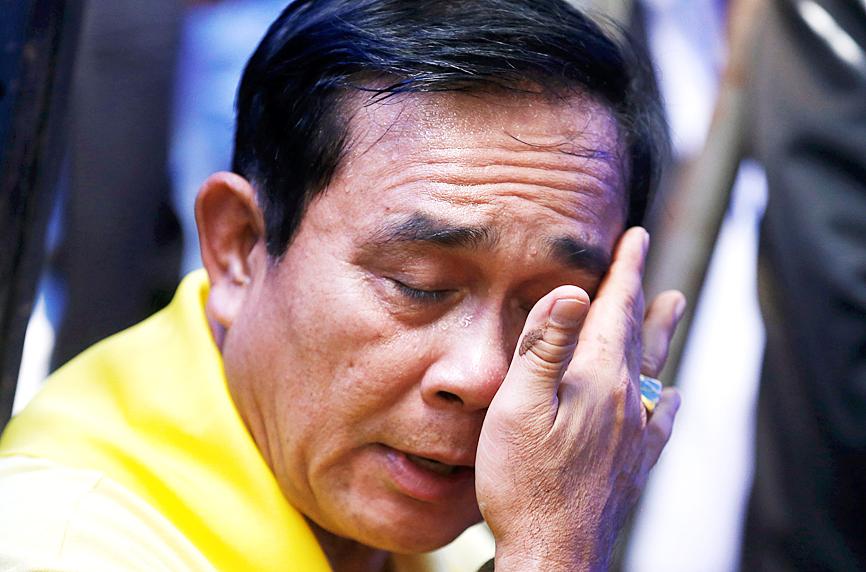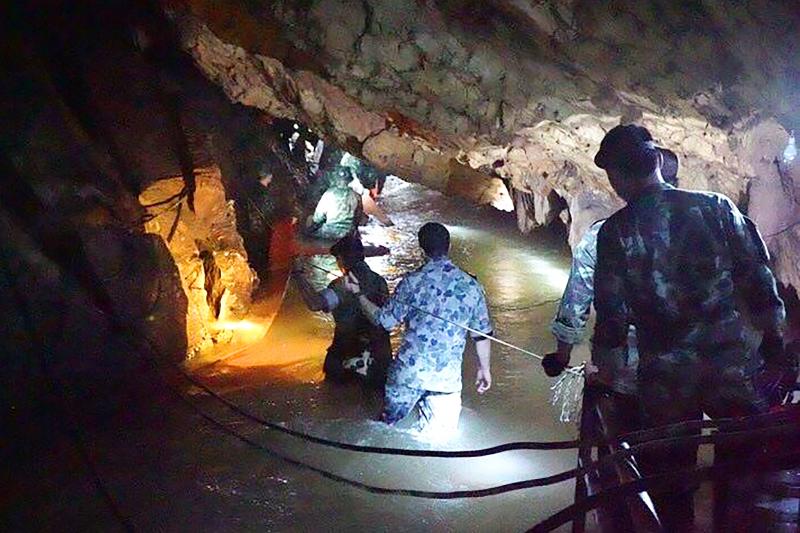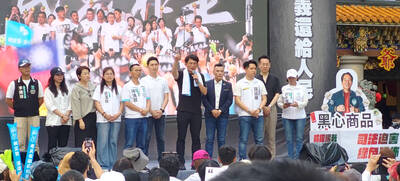The dramatic rescue of 12 youth football players and their coach from a flooded cave in Thailand in 2018, a captivating operation already revisited in an award-winning documentary, is now getting the big-screen dramatic treatment from Ron Howard.
Thirteen Lives hits theaters in North America on July 29, and the Oscar-winning Howard — who cast a mix of bankable stars and untested talent in the movie — says making the film was an “exciting challenge.”
He called his latest a “very extreme version of my favorite kinds of films — you know, the kinds of films that prove that remarkable outcomes are not the stuff of fiction, that when people pull together, incredible things can happen.”

Photo: REUTERS
Thirteen Lives — which stars Joel Edgerton, Colin Farrell and Viggo Mortensen — retells the story of the spectacular rescue of the 12 boys and their coach who, in June 2018, found themselves trapped in Tham Luang cave for more than two weeks.
Recreating the conditions of the intense incident was both physically and psychologically challenging for the actors.
Farrell, who plays British cave diver John Volanthen, said during a screening of the film’s trailer on Monday that it was “terrifying” to film most of the time under water, even under expert supervision.

Photo: EPA-EFE
It didn’t help that Farrell, by his own admission, “can’t really swim.”
“It’s a different world beneath the surface of the water,” the Irish actor said. “Water’s wet, no matter how much control you have or don’t have.”
‘MANY BRANDS OF HEROISM’

Photo: AFP
The spectacular rescue is already the subject of the 2021 National Geographic documentary The Rescue, which featured some never-before-seen footage obtained from the Thai military after two years of tough negotiations.
Howard attempted to delve even more into the personal drama, and highlight the work of those who volunteered to help, at risk of their own lives.
“It was this ongoing process of... creating the environment and the effort, and then attaching the humanity to it,” the director said. “There are all kinds of, many brands of heroism that are demonstrated through the movie.”
He also emphasized the need to accurately depict the local population in Thailand’s northern province of Chiang Rai — the teens in the film are played by actors from the area, so that the language spoken is authentic.
“It’s not just an accent Business-leisure travelers are a subset of digital nomads, living and working abroad for longer than a typical holiday without taking up permanent residence it’s also phrasing,” said Howard, who worked with the film’s co-producer Vorakorn “Billy” Ruetaivanichkul, to help the boys understand the mindset of those who were trapped. “I asked them... imagine that you are in a tight space and imagine that you have a lack of food and water for a few days already, and you are unlikely to get out very soon,” Ruetaivanichkul said.
‘BURDEN BUT AN HONOR’
Mortensen highlighted the “team-oriented effort” of making the film, noting that it mirrored the relationships between the real-life rescuers the actors were playing.
For his part, Farrell spoke about the “responsibility to honor the lives that were passed and not just the spirit of those who survived the rescue,” recalling that two people associated with the cave extraction died.
“It was a burden but an honor, and we were really aware of it,” he said.
Thirteen Lives will be available in August for streaming via Amazon Prime after its cinematic release.

“Why does Taiwan identity decline?”a group of researchers lead by University of Nevada political scientist Austin Wang (王宏恩) asked in a recent paper. After all, it is not difficult to explain the rise in Taiwanese identity after the early 1990s. But no model predicted its decline during the 2016-2018 period, they say. After testing various alternative explanations, Wang et al argue that the fall-off in Taiwanese identity during that period is related to voter hedging based on the performance of the Democratic Progressive Party (DPP). Since the DPP is perceived as the guardian of Taiwan identity, when it performs well,

The Taiwan People’s Party (TPP) on May 18 held a rally in Taichung to mark the anniversary of President William Lai’s (賴清德) inauguration on May 20. The title of the rally could be loosely translated to “May 18 recall fraudulent goods” (518退貨ㄌㄨㄚˋ!). Unlike in English, where the terms are the same, “recall” (退貨) in this context refers to product recalls due to damaged, defective or fraudulent merchandise, not the political recalls (罷免) currently dominating the headlines. I attended the rally to determine if the impression was correct that the TPP under party Chairman Huang Kuo-Chang (黃國昌) had little of a

At Computex 2025, Nvidia CEO Jensen Huang (黃仁勳) urged the government to subsidize AI. “All schools in Taiwan must integrate AI into their curricula,” he declared. A few months earlier, he said, “If I were a student today, I’d immediately start using tools like ChatGPT, Gemini Pro and Grok to learn, write and accelerate my thinking.” Huang sees the AI-bullet train leaving the station. And as one of its drivers, he’s worried about youth not getting on board — bad for their careers, and bad for his workforce. As a semiconductor supply-chain powerhouse and AI hub wannabe, Taiwan is seeing

Jade Mountain (玉山) — Taiwan’s highest peak — is the ultimate goal for those attempting a through-hike of the Mountains to Sea National Greenway (山海圳國家綠道), and that’s precisely where we’re headed in this final installment of a quartet of articles covering the Greenway. Picking up the trail at the Tsou tribal villages of Dabang and Tefuye, it’s worth stocking up on provisions before setting off, since — aside from the scant offerings available on the mountain’s Dongpu Lodge (東埔山莊) and Paiyun Lodge’s (排雲山莊) meal service — there’s nowhere to get food from here on out. TEFUYE HISTORIC TRAIL The journey recommences with